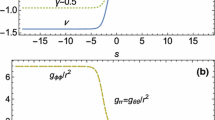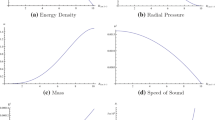Abstract
We determine equilibrium configuration of Emden-Chandrasekhar axisymmetric, solid-body rotating polytropes, defined as EC polytropes, for polytropic indices ranging from 0 (homogeneous bodies) to 5 (Roche-type bodies). To this aim, we improve Chandrasekhar's method to determine equilibrium configurations on two respects: namely, (a) no distinction exists between undistorted and distorted terms in the expression of the potential, and (b) the comparison between the expressions of gravitational potential and its first derivatives inside and outside the body has to be made on the boundary of a sphere of radius ΞE, which does not necessarily coincide with the undistorted Emden's sphere of radius\(\bar \xi _0 \geqslant \Xi _{\text{E}} \). We also allow different values of\(\bar \xi _0 \) for different physical parameters, and choose a special set which best fits more refined results (involving more complicated and more expensive computer codes) by James (1964). We find an increasing agreement with increasing values of polytropic indexn and vice-versa, while a large discrepancy arises for 0≤n<1, which makes the approximations used here too much rough tobe accepted in this range. A real slight non-monotonic trend is exhibited by axial rations and masses related to rotational equilibrium configurations — i.e., when gravity at the equator is balanced by centrifugal force-with extremum points for 4.8<n<4.85 in both cases. The same holds for masses related to spherical configurations, as already pointed out by Seidov and Kuzakhmedov (1978). Finally, it is shown that isotrophic, one-component models of this paper might provide the required correlation between the ratio of a typical rotation velocity to a typical peculiar velocity and the ellipticity, for about\(\tfrac{3}{4}\) of elliptical systems for which observations are available.
Similar content being viewed by others
References
Caimmi, R.: 1980,Astrophys. Space Sci. 71, 415 (Paper I).
Caimmi, R.: 1983a,Astrophys. Space Sci. 89, 255 (Paper II).
Caimmi, R.: 1983b,Astrophys. Space Sci. 93, 403.
Chandrasekhar, S.: 1933,Monthly Notices Roy. Astron. Soc. 93, 390.
Chandrasekhar, S. and Lebovitz, N. R.: 1962,Astrophys. J. 136, 1082.
Jabbar, J. R.: 1984,Astrophys. Space Sci. 100, 447.
James, R. A.: 1964,Astrophys. J. 140, 552.
Linnell, A. P.: 1977,Astrophys. Space Sci. 48, 185.
Linnell, A. P.: 1981a,Astrophys. Space Sci. 76, 61.
Linnell, A. P.: 1981b,Astrophys. Space Sci. 80, 501.
MacMillan, W. D.: 1930,The Theory of the Potential, Dover Publ., London.
Seidov, Z. F. and Kuzakhmedov, R. K.: 1978,Soviet Astron. 22 (6), 711.
Author information
Authors and Affiliations
Rights and permissions
About this article
Cite this article
Caimmi, R. Emden-chandrasekhar axisymmetric, rigidly rotating polytropes. Astrophys Space Sci 113, 125–142 (1985). https://doi.org/10.1007/BF00650276
Received:
Issue Date:
DOI: https://doi.org/10.1007/BF00650276




